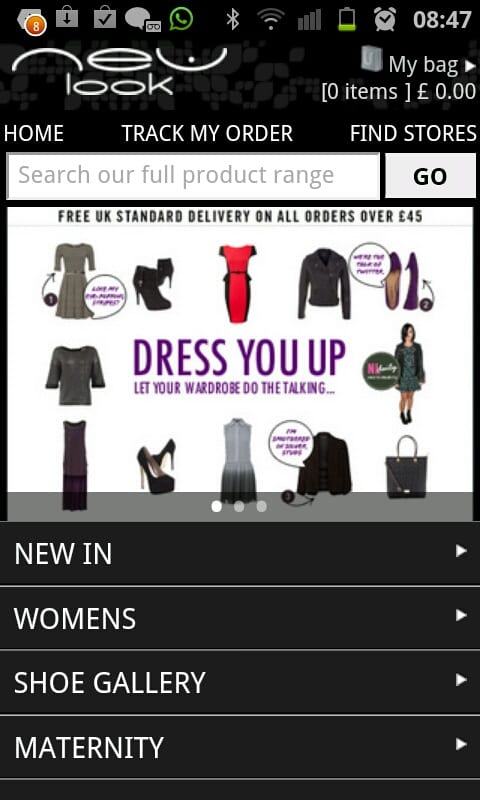8 reasons to invest in mobile marketing
Mobile marketing is fast becoming a mainstream activity for those companies that get it. But for every company that does, there are many more that still don’t. Whether it’s because they think it’s a passing fad, or because they don’t quite know where to start, these companies are missing out on a commercial revolution. Here then, are eight reasons why you can’t afford to ignore mobile marketing…learn more from companies already reaping the benefits of mobile presented at the upcoming Mobile marketing Live on the 1st and 2nd October at London.
Reason 1: Consumers are already there

Marks & Spencer mobile site
When Marks & Spencer became the first UK retailer to launch a mobile-optimised, transactional website on 12 May 2010, its rationale came from an analysis of traffic to its website. Five per cent of it was coming from mobile devices, and that was enough to convince M&S it needed to cater for these users. Less than five months later, the site had attracted 1.2m unique visitors, and taken more than 13,000 orders, with the largest single order for £3,280, for two sofas.
Recently, Debenhams revealed that 20 per cent of its traffic was coming from mobile devices. If you want a more subjective analysis of the situation, take a look around you the next time you get on a bus or a train; people are ‘grazing’ on their mobile phones, sometimes researching, sometimes shopping. If you’re not at the party, you won’t get a date…
Reason 2: The High Street is suffering
In case you hadn’t noticed, it’s a mess on the High Street right now. The Local Data Company’s (LDC) mid-year shop vacancy report for 2012, derived from 506 town centres and 145,000 shops that it visited between January and June 2012, revealed an average vacancy rate in Great Britain of 14.6 per cent. According to the report, almost 15,000 shops closed in town centres in the nine years between 2000 and 2009, but a further 10,000 closed in 2010 and 2011.
At the same time, the report reveals that online sales are being accelerated by mobile technology, and are expected to reach 13.2 per cent by the end of 2012. Savvy retailers are turning to mobile, not only to enable customers to buy from them while they’re waiting for their bus to arrive, but also, to drive them into their stores, with location-based mobile advertising and coupon campaigns
Coupons have a big part to play in mobile’s future.
Reason 3: A full-fat website looks awful on a mobile phone
The point about a mobile-optimised site is that it’s, er, optimised for mobile. Take a site that isn’t (try apple.com as an example) and compare it to one that is (newlook.com) and the difference is plain to see. Say a woman has two favourite shops she goes to for her clothes and one has a mobile-optimised site and the other doesn’t - she is much more likely to buy from her phone from the first than the second.
Here is an example of a non mobile optimised site.

The simplicity offered from a mobile-optimised site is clear:

Add to this the sheer number of people shopping on their mobile phone and it becomes something of a no-brainer. According to the IAB’s ‘Mobile in the Retail Store’ study from January 2012, 92 per cent of UK shoppers use the web to research purchases while on the move. Of these, half went in store to buy the product, while 28 per cent bought it on their mobile phone.
Reason 4: Second screening is a fact of life
Statistics from mobile ad network Adfonic, based on an analysis of its hourly click patterns, reveals that traffic starts to build from around 6pm and continues to rise throughout the evening.

Forward-thinking brands are capitalising on this trend. It started with simply adding mobile calls to action to TV ads, such as inviting viewers to text in to a shortcode for more information, but it is now being taken further.
The music discovery service, Shazam, enables mobile users to identify a song they hear being played by launching the Shazam app and letting it sample 30 seconds of the song. Now, Shazam has launched its Shazam for TV service, which enables TV advertisers to make their ads ‘Shazamable’. When the ad appears, complete with the Shazam logo, Shazam users can tag the ad with their phone to engage with the advertiser.
Shazam for TV made its UK debut on 12 May 2012. Pepsi MAX and Cadbury’s were the first two brands to deploy the technology. Viewers could Shazam the Pepsi Max ad to enter a sweepstake to win tickets to summer festivals and other Pepsi MAX merchandise. Viewers could also tag the Cadbury’s Unwrap Gold ad for a chance to win a London 2012 Opening Ceremony ticket package.
Reason 5: Your competitors are already doing it
If you haven’t yet started working on your mobile strategy, take a look at your competition and see where they are at. Chances are you are behind the game. To get some idea of how advanced your competition’s mobile strategy is, type their web address into a mobile browser and see whether you are taken to a mobile-optimised site. Type their name into the iTunes and Google Play app stores and see what comes back.
Of course, Amazon and eBay have been deploying mobile apps and sites for years now and generate a significant amount of their business via M-commerce, so it's worth keeping a close look at their latest approaches.

Research released in August 2012 revealed that 37 per cent of the top 100 UK advertisers had a mobile-optimised site. This is a sign that there is still a long way to go, but also, that companies, including your competitors, are beginning to get their act together.
Reason 6: That mobile in your hand is not a mobile - and it knows where you are
It’s a mini computer, with as much processing power as a PC of only a few years ago, and, arguably, more intelligence than the best-spec PC in the store. Because one of the key points of difference between a PC and a mobile phone is that the mobile knows where you are.
Not only that, it also knows whether you are facing North, South, or anywhere else in between. This is already being tapped into by advertisers, targeting consumers via ads in mobile apps or on mobile sites when they are within a certain distance to one of their stores, or even one of their competitors’.
It’s being used in other ways too, such as the FindaProperty app that uses Augmented Reality to enable users to see details of properties for sale around them simply by holding their phone in front of them, point towards the area they are interested in.
Reason 7: It’s the web all over again
And there’s no going back. When the internet first appeared on the scene, traditional retailers were slow to get it. Which is why pureplay online retailers like Amazon and eBay were able to build up such a position of strength. Eventually, retailers realised that the web was not going to go away, and as initial concerns about the safety and security of online shopping (remember them?) evaporated, they realised too that it was an important new shopping channel for consumers.
Given that last year, more mobile phones were shipped than PCs – 488m compared to 415m according to Canalys - and that, according to Microsoft, mobile browsing should overtake PC browsing some time in 2014, there can surely be no logical argument to suggest that mobile is a passing fad that you can afford to ignore. It is only going to become more strategically important to your business, and for the kids just getting their first phone, the mobile life will just be normal life.
Reason 8: The numbers say it all
There is currently a massive imbalance in the ratio of consumer time spent on mobile versus ad spend in the channel, compared to other media. According to figures from VSS, Mary Meeker, comScore, Alexa and Flurry Analytics, in 2011 in the US, TV commanded 43 per cent of consumer time and took 40 per cent of ad spend, while mobile commanded 23 per cent and took just 1 per cent of ad spend.
Ad spend always follows eyeballs sooner or later, but when the disparity is as large as it is here, it seems inevitable that brands are going to pile in to the mobile space. And indeed, mobile ad spend is growing. According to the annual study carried out by the IAB and PwC, mobile ad spend in the UK in 2011 was £203.2m. up from £83m in 2010, and just £28.6m in 2008.
In Summary:
- Mobile is becoming a primary content channel - Consumers are turning to mobile to buy, to research purchases, and to augment their TV viewing
- Always on - A transactional mobile app or site enables your customers to buy from you whenever and (almost) wherever they are
- Spend on mobile is increasing – if you have not started working on your mobile marketing strategy, chances are your competitors have.
- Is it a phone? – Not really, the modern smartphone is a powerful, location-aware computer that could not be better suited to commerce.
- It’s here to stay – web browsing is moving from the PC to the smartphone and from the moment they get their first mobile phone, the mobile lifestyle – including mCommerce – will be second nature to tomorrow’s adults.

Thanks to
David Murphy for sharing their advice and opinions in this post. David is editor of
Mobile marketing magazine and organiser of
Mobile Marketing Live. This is a 2-day exhibition, conference, training and networking event taking place in London on 1-2 October, 2012. You can connect with him on
LinkedIn.








 Thanks to
Thanks to 


